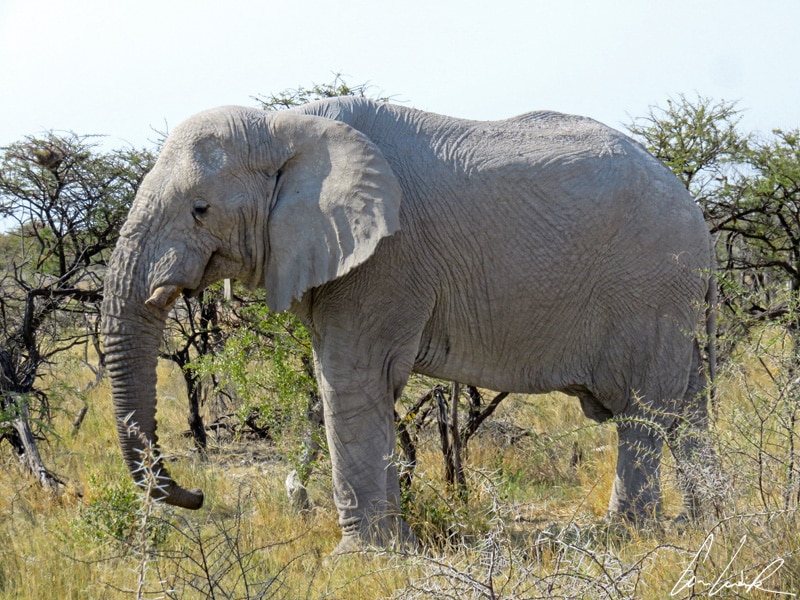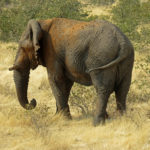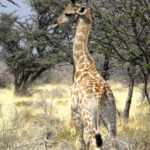For most people, African fauna consists of felines or the famous “Big Five”– the five African animals that all travelers dream of seeing and photographing. The expression “Big Five” does not refer to the animals of Africa that are the largest in stature, but big-game hunters created the term and to refer to the five African animals most commonly hunted on foot. The “big five” animals are his majesty Simba the Lion, Sabor the Leopard, Dumbo the Elephant, Rocky the Rhino, and the Buffalo Bogo. If these names don’t ring any bells, it’s time for you to review your Disney classics! We can meet all these “animal stars” in Namibia, but they do not necessarily live in the same park…. Yes, the world of show biz is merciless, we don’t hang out in the same places! For example, the Buffalo is absent from Etosha National Park, yet it is the largest animal sanctuary in Namibia!
Let’s explore one of the many trails in this vast reserve and see the savannah that inspired “The Lion King”. We turn the sound on full blast in our four-wheel-drive singing “Hakuna Matata” at the top of our lungs! However, the Lion King is not the source of this beautiful expression, which is much older. It is a motto derived from the Swahili “matatizo Hakuna”, meaning “no worries”.
« Hakuna Matata, what a wonderful phrase, Hakuna Matata, Ain’t no passing craze… It means no worries for the rest of your days; it’s our problem-free philosophy: Hakuna Matata »
Hakuna Matata – The Lion King

The heavyweights of the Etosha savannah
You may remember these lines given Timothy Q. Mouse in Disney’s classic “Dumbo, the flying elephant”:
« And it ain’t nobody’s fault you got the big ears. Oh boy, I stepped in it that time. Aw gee, Dumbo, I think your ears are beautiful! Sure! As a matter of fact, I think they’re very decorative. You know, lots of people with big ears are famous ! »
The African elephant is characterized by its large ears, which are larger than those of its cousin the Asian elephant. It uses his ears to regulate its temperature. Indeed, as the elephant does not sweat, one means of cooling himself is to flap his ears. The wrinkled skin of the elephant is about one inch thick and has little hair, making it dry and fragile. However, these wrinkles are more than just folds ! The skin is lined with tiny channels that are linked to each other to form a polygonal network, which looks like cracks in a dried mud… According to biologists at the University of Geneva, these tiny cracks are used to regulate the body heat of African elephants. Indeed, the skin of the African elephant could store up to ten times more water than a smooth skin…
The elephant regularly bathes and takes dust baths to protect himself from the sun and parasites. The elephant’s tusks are large modified incisors. They weigh from 51 to 91 lb and can be 5 to 8 feet long. In perpetual movement for most of the day, the elephant moves to find food. Indeed, the animal spends two-thirds of his day looking for food, and the final third sleeping either standing or lying down. He may eat as much as 1,000 pounds of vegetation per day.

Although elephants are anchored in our collective imagination (thank you Disney) as gentle animals, when visiting the park don’t forget that the savannah elephant is the most massive and largest living animal. These pachyderms weigh several tons, heavier than six cars. The male weighs up to 6.6 tons, females up to 3.5 tons. They can sometimes be aggressive. Moreover, if an elephant is charging, leave as quickly as possible… because even if elephants cannot run, they can walk at a speed of up to 15 mph. They always have one foot on the ground because of their mass; technically they don’t run.

What do we see on the horizon ? Could it be another mammal in the “heavyweight” category, cousin of Rocky the Rhino, approaching slowly, but surely in our direction
« But who is this Rocky the Rhino you’re talking about here?
Well, I’m talking about Rocky, the character from Rudyard Kipling’s Jungle Book, published in 1894.
I don’t know this Rocky, and yet I’ve seen “The Jungle Book” on DVD at least thirty times.
Okay, forget it, he was removed from the cartoon at Walt Disney’s request… »
Engine off (like the cartoon sequence), we patiently wait for this mastodon to get closer so we can study his upper lip. Why is his lip? Because we have a wild desire to know if we have in front of us a Black rhinoceros (hook-lipped rhinoceros) or a White rhinoceros (square-lipped rhinoceros). Ha, ha because of course it would be too easy: the White rhinoceros is not white, but grey, just like its cousin the Black rhinoceros which is not black, but grey. Are you following me ? Why on earth are the two species of rhinos called “black” and “white” when they are grey ? A priori because of a misinterpretation of the Afrikaans word “wyd,” meaning wide, referring to its square-upper lip as opposed to the pointed or hook-like lip of the Black rhinoceros. The Anglo-Saxons have unfortunately translated it as “white,” As for the Black rhino, since he spends much time wallowing in the mud, he has a darker appearance… and is therefore known as the Black rhino.

The White Rhino is herbivorous. Its square upper lip and jaw allow it to graze easily. The Black rhino is phyllophagous, i.e., it eats leafy plants, buds, and twigs. It uses its hooked upper lip to strip the branches of their leaves. Another distinctive difference between B&W is that the calf of the Black rhino follows his mother, while the young of the White rhino walks in front. For this reason, young Black rhinos are regularly attacked by Hyenas, and their ears are often torn apart as a result of these attacks. An adult Rhinoceros has no natural predators other than humans.
Kings and queens of Etosha Park
Sometimes surprise encounters change your day ! His Majesty Simba the Lion, King of Beasts, is the largest carnivore in Africa. The male Lion is recognized by his magnificent mane, usually dark brown and tinged with yellow, rust and black hairs. The lion loses his mane for a few weeks once a year (yes, the lion molts). Lions (Panthera leo) rank second among the biggest cats after the Tiger. The Lion is sexually dimorphic. Males are larger than females. Males weight between 330 and 550 pounds and female between 265 and 400 pounds. Male are more muscular and stronger than females. With their powerful and muscular legs, they can break the bones of prey with a single kick! However, they often prefer to choke their victim by grabbing them by the throat with their powerful jaws. Lions spent much of their time resting. They are inactive for an average of about 15 hours a day !

It is most often the smaller (but still muscular !) lionesses that hunt, the role of the male being to protect the territory from intruders. Groups of female lions hunt together. Their hunting technique consists in approaching their prey on the ground, hidden by the tall grass, and then attacking in a coordinated manner. They attempt to catch their prey with a headlong rush and a final leap, killing by strangulation or by enclosing the preys mouth and nostrils in their jaws. Pulverizing Usain Bolt‘s record, these cats can run 100 meters in 5 seconds… Their maximum speed is about 50 mph for short distance. The females are the fastest in this sport. As for the long jump record held by American Mike Powell, it is also beaten since lions can leap as far as 36 feet long and up to 13 feet high. On the vocal side, the lion would make any opera singer pale with envy since his roar exceeds 115 decibels. A human voice can reach a maximum of 120 dB…
Sophie the giraffe: A major curiosity in Etosha
Who hasn’t been in contact with Sophie the giraffe during his childhood ? In 1961 Delacoste created this 18-centimeter high rubber giraffe as the indispensable baby toy. It achieved iconic status in France. Sophie was also popular in the United States and even appeared in the comedy film directed by Leonard Nimoy, Three men and a baby, released in 1987 starring Tom Selleck, Steve Guttenberg, and Ted Danson. I am confident that your senses are reawakened just by mention of Sophie… Remember its delicate touch with its raised parts, its magnificent appearance with its contrasting colors, the inimitable sound of its squeak and the taste of its natural rubber… But long before Sophie’s birth, the giraffe had long fascinated man. Very old cave paintings found in the Sahara desert represent giraffes attacked by indigenous people with arrows and spears. As for Julius Caesar, he made the giraffe a symbol of his African conquests. In the 15th century, Florentine princes and the Emperor of China adorned their gardens with giraffes… Welcomed with great fanfare in Marseille in 1826, the first giraffe of France, known today as Zarafa, was a present to Charles X of France from the Ottoman Viceroy of Egypt, Mehmet Ali Pasha. She traveled the 880 kilometers from Marseille to Paris by foot in 41 days. She was presented to the King on July 9, 1827. She took residence at the Jardin des Plantes for 18 years until her death. Today, she can be seen at the Museum of Natural History of La Rochelle. Her arrival in Paris caused a sensation, approximately an eighth of the population came to see her. The event triggered a fad, numerous “girafomania”: poems were composed, cakes were made in the shape of a giraffe and clothing fashion turned yellow and brown, known as “belly of giraffe”…
« The Giraffe for the King of France was taken to Marseille on a Sardinian ship: she suffered some bad weather; nevertheless she recovered very quickly; and after having satisfied herself and her servants with the laws of quarantine, she entered Marseille on November 14, 1826. The Préfet, Count of Villeneuve, installed her in the outbuildings of his hôtel particulier, where she received special care, because of which she never ceased to enjoy, during her stay in Marseille, the best of health »
by Étienne Geoffroy Saint-Hilaire, Quelques Considérations sur la Girafe, 1827
According to Étienne Geoffroy Saint-Hilaire, she was called “The beautiful animal of the King” and “The beautiful African” by contemporary press. The paper “La Gazette” referred to her as “Her Highness”. Discovering “for real” this large and beautiful animal, with its unique spotted coat, black deer eyes, and blue tongue is a highlight of our safari. Moreover, she deserves the title of queen and undisputed beauty of the savannah so much so that she seems to prance in front of the lens like a model in a fashion show.

The tallest and the largest ruminant terrestrial animal is easily visible on the horizon. You can perceive her slender silhouette and graceful appearance long before you see her yellowish or white coat spotted with orange, brown and even black touches. With a haughty air (ah, ah it is apt to say it) she walks in the savannah and open woodland, using her impressive 18 inches long purple-black tongue to grasp foliage high up on trees beyond the reach of other browsers. The giraffe can stand between 14 and 18 feet tall. Males are taller than females. The tallest male was 19.3 feet, 17 feet for the tallest female. The average weight is about 2,628 pounds for a male and about 1,825 pounds for a female. Despite her tall appearance, her body is relatively short. Her neck can be between 6,6 and 7,9 feet long. Both genders have two horns, called ossicones, formed by bony cartilage and covered with skin. The ossicones of females and young are thin and display tufts of hair on top, whereas those of males are almost completely bald on top due from fighting (called “necking”) with other males.
Her vertiginous elongated neck caught our attention. It is unique in the animal world. Like any mammal, her neck has seven vertebrae. This long neck results from an excessive lengthening of the cervical vertebrae, and not from additional vertebrae. These 1-foot vertebrae fascinate physiologists, including those in NASA who use the giraffe to study the effect of gravity on blood circulation. Like the zebra’s stripes, the neck of giraffes has been the subject of much speculation. Why do giraffes have such a long neck? If the theory of evolution claims that the giraffe’s neck has grown to adapt to the environment, the discovery of fossils of giraffokeryx (the giraffe’s ancestor) living 5 million years ago has completely rejected this theory. The giraffokeryx had a neck as long as our modern giraffe… Like the zebra’s stripes, Mother Nature refuses to reveal the mystery of this endless neck! Evolution must have had a good reason for getting there, right? Another evolutionary hypothesis being discussed today is that females prefer males with longer necks… No comment! To break the neck of preconceived ideas, I prefer to stick to this cute legend…
« A long time ago, a multitude of animals lived in Noah’s Ark: lions, giraffes… and birds, butterflies, snails… All these nice folks got along very well. Each of the animal families were assigned tasks on the Ark, but the giraffe family was not doing their job very well, and the Lion King was furious. So the Lion ordered the giraffe to install a flag at the top of a tall mast. It was a challenging job because the mast was really very high. So all the animals helped the giraffe. Everyone who could fly stretched his neck. The others made much effort to lengthen his legs… And it is since that day that giraffes have big legs and a long neck ! »
Thanks to its long, muscular “Smurf” tongue, which can measure up to 2 feet, she is not afraid of the spines of acacias: young shoots full of water, leaves, fruits, twigs, pods. The giraffe eats about 75 pounds of foliage a day! Her favorite dish is the leaves of Acacia erioloba, which for this reason is called the “Giraffe tree”. Like the elephant, giraffes move constantly and travels long distances in search of food while ruminating. And yes, giraffids probably have a common ancestor with bovids because the giraffe chews its food, swallows it for processing, and regurgitates half-digested foods impregnated with saliva and digestive juices into the mouth to chew again.

Compared to our big. sleeping feline friends, the giraffe sleeps very little: on average two hours a day! They rarely take naps longer than 20 minutes and sleep deeply for only a few minutes. Because of their size, eyesight, and powerful kicks, adult giraffes have few predators. She only fears lions with whom she can compete in a race as she reaches a peak speed of 40 mph and can sustain 30 mph for several kilometers. Baby giraffes that escape their mothers’ surveillance are vulnerable. They are easy prey for leopards, hyenas, wild dogs, and lions. About 50% of baby giraffes fall under the fangs or claws of predators… As a Quebec philosopher says..:
« Life is sometimes ruthless. So is death. One never goes without the other…. That whoever lives dies is a law of nature ! »
by Françoise Dumoulin-Tessier
At birth the newborn giraffe is about 6 feet tall and weighs between 80 and 175 pounds. The birth itself is already a danger. Giraffes give birth standing up. The baby giraffe, head and legs first, falls almost 8 feet high to the ground, and can potentially injure itself, even breaking its neck, although this is rare. Generally, the giraffe does not appear to suffer from this fall and stands on its four shaky legs 5 to 15 minutes after birth. Within a few hours of birth, the newborn can run. For the first three weeks, calves spend their time hidden.

As night falls on this animal sanctuary, Zazu, the famous red-billed hornbill (majordomo to Mufasa and later Simba) perched on its branch watches us leaving the park with regret. Kwa heri! (Goodbye in Swahili). Once again, the colors dance, writhe, whirl, twirl like mother-nature pirouetting to sensual music, a music that closes the discovery of Etosha National Park. Another click-click to immortalize this careful choreography in a snapshot of a beam of orange-red light bursting through a glowing sky, a dramatic sunrise over the savannah.
Find more on Namibia
- Waterberg Plateau Park !
- Lake Otjikoto, a lake that digs its own hole !
- A glimpse of Etosha National Park
- In the heart of the Etosha National Park wildness
- Epupa Falls: rendezvous in Himba land
- Encounter with Desert Elephants and Welwitschia Mirabilis
- The Petrified Forest and Rock Carvings of Twyfelfontein
- The Mysterious Skeleton Coast, and Cape Cross’ Fur Seals
- Walvis Bay:Rendezvous with Desert and Ocean



















